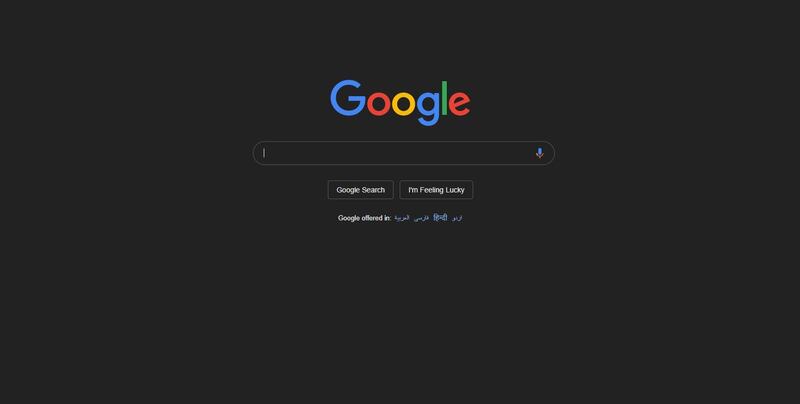All over the world, computer screens are going dark. (Well, darkish.) For more than 30 years we've been used to working on screens with backgrounds that are predominantly white, and text that's usually dark. At this very moment I'm typing into a word processing document that started out as a white rectangle, which was evidently intended to replicate the look of ink on paper. But over the past 12 months, operating systems and applications on computers, tablets and phones have dangled the option of "Dark Mode" for anyone who might prefer their text to be bright and backgrounds to be more shadowy.
In the past couple of weeks, Google's Chrome browser and Facebook's Messenger app have announced the introduction of Dark Mode, while Apple's next operating system, iOS13, should also have it as a feature. But why is this happening now? Are we simply desperate to reskin our computing environment in the same way we might redecorate our living rooms? Or are there tangible benefits to using Dark Mode – and if so, why has it taken so long for us to realise it?
Why people use Dark Mode
The twin reasons often given for the Dark Mode trend is that we're looking to soothe our eyes and preserve our batteries. Google said that using Dark Mode can extend the battery life of Android phones, but this isn't the case across the board; for devices with OLED screens it can work wonders, but for LCD screens the difference is minimal. The benefit to our eyes also varies from person to person, but in an era when we're spending more and more time staring at screens, Dark Mode is widely considered to be a way of avoiding headaches.
"If you're designing something for long periods of use, it's important that the interface isn't distracting," says designer and user experience expert Cennydd Bowles. "There is a theory that darker interfaces reduce eye strain, and some people even claim that it offers better legibility of text. But studies have found the evidence for that to be inconclusive."
In the earliest days of computing, bright text on dark backgrounds was all you got, with electron beams fired at dark phosphor-coated screens to produce lines of green or amber code. The influence of this aesthetic is still felt strongly today, with a widespread sense among the coding community that a dark background is the "correct format" for such work. "Dark Mode seems to evoke an era of serious computing, a time when it was a niche activity and you had to know what you were doing," says Bowles. "I think some people secretly resent the opening out of computing to people who don't have those technical skills, so maybe Dark Mode is a way of recapturing that era when computing was a bit more inaccessible."
A history of going dark
The inversion of computer displays to black text on white began in the 1970s with the invention of graphical user interfaces (GUIs), code-free environments that were designed to be consumer friendly. “You always try to design using metaphors that people are familiar with,” says Bowles, “and the idea of ink on paper was familiar to everyone.”
But if the GUI made light screens de rigueur in the 1980s, Bowles believes it was the advent of so-called Web 2.0 about 20 years later that made dark backgrounds even rarer. "Web pages before that time were often dense and dark," he says. "But the Web 2.0 aesthetic involved masses of white space and Dark Mode may well be a backlash against that, too."
The establishment of Web 2.0 design as fluffy, friendly and easy to interact with prompted the notion that darker environments were perhaps more suitable for "proper work". For example, many computer applications for architects, musicians and scientists have moved towards darker interfaces of late. But it was the introduction of Dark Mode in the most recent Mac operating system, Mojave, that brought it into the mainstream: whether you chose to use the cooler Dark or friendlier Light Mode, your computing life would be identical, but the emotional resonances would be different.
“That’s the power of design,” says Bowles. “With subtle tweaks you can suggest very different uses and different audiences for exactly the same software. Knowing how those small changes can have a big effect is the secret sauce of being a good designer.”
But who does it appeal to?
The ongoing rush by our favourite apps to offer a Dark Mode option – precipitated partly by the need to fit aesthetically with the operating systems in which they sit – has led to a range of dark hues, with no real consensus on what colour Dark Mode should be.
"We've been designing on white backgrounds for decades, but black simply doesn't work, it's too oppressive," says Bowles. "It has to be something slightly softer, but if you open four dark-themed applications, they won't hang together as a coherent design. It's messy. You should also be making typographic tweaks to light text on dark, but a lot of people aren't doing that. There are some pretty bad examples out there."
Generally, radical changes to our computing environment are not welcomed by consumers, but with Dark Mode being described as "trendy", "slick" and "mysterious", many of us will be tempted to give it a spin.
But who will end up sticking with it? Who does Dark Mode really appeal to? "I have a hunch, although I can't back up with hard data, that it's used more frequently in apps that appeal to men," says Bowles. "It's a known design trope; if you look at the way graphics cards and consoles are marketed – black, prestige, elite, go-faster stripes, lots of black and green – it's not surprising that the apps moving quickest to Dark Mode probably have a male skew."
Personally, I find Dark Modes uncomfortable to use; it almost feels like an alien environment. Fortunately, we are able to ignore those who have dogmatic views about which mode is the right one to use and can make our choice. It's up to us.










